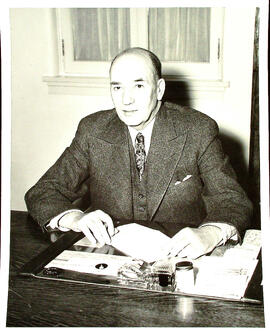- Person
- 1915-1982
George Barnett was born in Saskatoon in 1915. He entered medical school at the University of Manitoba in 1938. He spent a year out of university while being treated for pleurisy at the Fort San Sanatorium, but recovered and graduated in 1944. After graduation he served in the armed forces. In 1946, Dr. Ferguson obtained Dr. Barnett's early release from the armed forces (RCAMC) and he joined SATL as a medical doctor. In 1957 Dr. Barnett was appointed as Dr. Orr's assistant, and succeeded him as General Superintendent on December 15th, 1957. He retired in 1982. He received a Commemorative Medal for the 125th Anniversary of the Confederation of Canada, presented by the Governor General.





![Fort Qu'Appelle Indian [Indigenous] Hospital](/uploads/r/lung-sask/d/c/b/dcb5245ffeaa3ae7c62a211eb61396dca1c4ce0a159c1b533abbbca22bc927cf/FQIH_Exterior_2_142.jpg)







